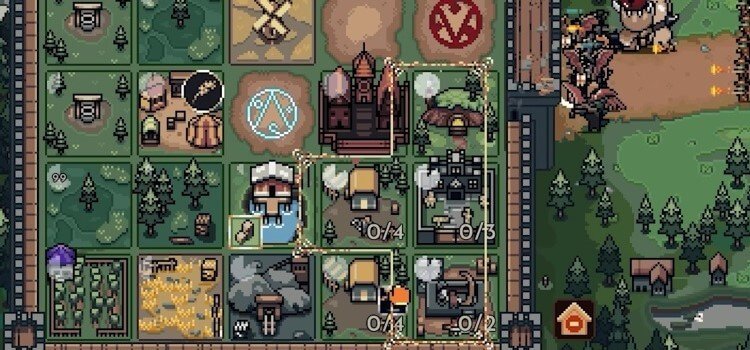The throne room is silent, save for the distant howls of monsters beyond your walls. Your subjects stand frozen—until your gaze falls upon them. Then, like clockwork, they spring to life: farmers till the soil, blacksmiths hammer steel, and archers nock arrows. But the moment you look away? They stop. Dead. In The King is Watching, a roguelite strategy game by Hypnohead, you are both ruler and overseer, a monarch whose very attention dictates the survival of your kingdom.
This isn’t just about building a castle—it’s about managing attention, optimizing production, and surviving relentless waves of enemies—all while balancing the fragile sanity of a ruler who must watch everything at once.
If you’re new to this unique blend of strategy and psychological pressure, this guide will walk you through the core mechanics, advanced tactics, and survival secrets to ensure your kingdom thrives rather than collapses into chaos.
The King is Watching Mechanic

In The King is Watching, your most vital resource isn’t gold or food—it’s your attention. Every building, every worker, every soldier only functions when you’re looking at them. The moment your gaze shifts, they freeze.
Why Gaze Size Matters
Your starting gaze covers a mere 3 tiles, meaning only a handful of buildings can operate at once. But fear not—this can be upgraded. Each Gaze Size upgrade expands your field of control, maxing out at 6 tiles (double the starting range). The upgrade button sits just above your Morale indicator, and each expansion requires specific resources. Prioritize this early—a wider gaze means more simultaneous production, faster defenses, and better resource flow.
Selective Attention
You can’t watch everything at once, so plan your gaze path carefully. Rotate between:
- Resource production (farms, mines)
- Unit training (barracks, archery ranges)
- Defensive repairs (walls, gates)
A common mistake is fixating too long on one area while enemies breach another. Stay mobile, methodical, and always aware of threats.
Building an Efficient Kingdom

Your castle starts bare, and every placement decision matters. A poorly arranged kingdom means wasted time, inefficient production, and inevitable collapse.
Essential Early-Game Buildings
- Farms & Mills – Food keeps your people alive. Bread is the most efficient, requiring wheat farms → mills → bakeries.
- Barracks & Archery Ranges – You start with zero defenses. Without units, monsters will overrun you.
- Housing (Hovels) – More peasants = more workers. Each hovel supports 8 idle hands waiting for your command.
Optimal Building Placement
- Cluster related buildings (e.g., farms near mills) to minimize gaze-switching.
- Keep military structures near walls so you can quickly reinforce during attacks.
- Leave space for future expansions—later waves demand more advanced setups.
tip: Hold Shift and drag buildings to reposition them. Yes, there’s a brief production penalty, but the long-term efficiency gains are worth it.
Military Strategy

in The King is Watching Monsters don’t wait. They come in waves, growing stronger, smarter, and more numerous. Without soldiers, your kingdom is a buffet.
The King is Watching Unit Types & Their Roles
- Peasants – Cheap but weak. Use them for repairs or as cannon fodder.
- Longbowmen – Essential for ranged defense. Place them on walls.
- Swordsmen – Strong melee fighters. Hold the frontline.
- Mages – Late-game powerhouses. Devastating but costly.
Unit Limits & Upgrades
Just like gaze size, your unit cap can (and must) be increased. The upgrade button sits near your gaze expansion option. More units = more survivability. Never stop recruiting.
Combat Tips
- Focus gaze on archers during attacks—they stop firing if you look away.
- Repair walls mid-battle—peasants can patch breaches if you watch them.
- Use chokepoints—funnel enemies into kill zones where your troops focus fire.
Tactics

Once you survive the early chaos, the real challenge begins. Here’s how to dominate the mid-to-late stages.
1. Dynamic Building Relocation
Your initial layout won’t suit later threats. Don’t hesitate to move structures:
- Shift barracks closer to weak walls.
- Move farms inward as outer areas become battlegrounds.
- Swap positions between production and military as needed.
2. Morale Management
Your people’s happiness affects efficiency. Keep morale high by:
- Avoiding over-taxation (each tax level reduces happiness).
- Building taverns (ale boosts morale).
- Balancing work shifts—don’t exhaust peasants.
3. Preparing for Boss Waves
Some waves introduce elite monsters that shred defenses. Before they arrive:
- Stockpile resources (you won’t have time to farm mid-fight).
- Mass-produce high-tier units (mages, knights).
- Pre-repair walls—a single breach can doom you.
Common Mistakes
Even seasoned rulers falter. Here’s what not to do:
1. Ignoring Gaze Upgrades
A small gaze means slow production, weak defenses, and inevitable collapse. Always prioritize expansion.
2. Letting Units Idle at Max Capacity
If a barracks has trained its max units, stop gazing at it. Shift focus to understaffed areas.
3. Poor Wall Placement
Walls should create layered defenses, not just encircle the kingdom. Use multiple barriers to slow enemies.
4. Overlooking Peasant Labor
Peasants aren’t just cannon fodder—they repair walls, build structures, and gather resources. Keep some alive!
The King is Watching is a game of attention, strategy, and ruthless prioritization. One misstep—a gaze held too long on farms while enemies swarm the gates—can unravel hours of progress. But master these mechanics, and you’ll forge a kingdom that survives the night.